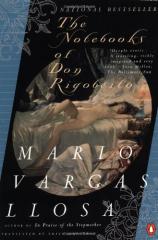Reading Group Guide
Discussion Questions
The Notebooks of Don Rigoberto

1. What distinctions does Don Rigoberto make between erotica and pornography? Do you agree or disagree with his opinions?
2. Discuss the use of art in one or both books. How do the three main characters use art to communicate their feelings toward each other? What do you think Vargas Llosa is saying about art's place in our lives?
3. Is Don Rigoberto someone we can admire? Is he a good husband to Lucrecia, or a good father to Alfonso? How do you think he would be perceived by co-workers, friends, or neighbors who knew little about his romantic life? Does Don Rigoberto strike you as a civilized man? Why or why not?
4. "I don't know if I like being called good," comments Don Rigoberto, "All the good people I've known were pretty imbecilic." What distinction is Vargas Llosa making between morality and behavior? Is being happy a necessary consequence of being good? What's the point of being good if one isn't happy? How do you think author and/or character would define "good"?
5. What do you think of Alfonso? What role does he play in Lucrecia and Rigoberto's reconciliation? If he did write the letters, should the couple be grateful to him for bringing them back together, or condemn him for his dishonesty? What do you think Alfonso's motives were for wanting the two lovers to be reunited? Do you think he has inherited his father's appreciation for individual liberty?
6. Why do you think Vargas Llosa chose Egon Schiele as an alter ego for Alfonso? What similarities are there between the two men's lives? How does Schiele's artistic style fit in with the themes of the novel?
7. What do you think of Lucrecia's relationship with Alfonso in In Praise of the Stepmother? Do you think Don Rigoberto should forgive her for sleeping with her stepson? What limits should we place—if any—on sexual freedom? What, besides the "inappropriateness" of their relationship would a man like Don Rigoberto object to?
8. Vargas Llosa offers a rare glimpse into Lucrecia's past: "Ever since she was a girl [she] had felt a fascination for standing on the edge of the cliff and looking down into the abyss, for keeping her balance on the railing at the side of the bridge." What does this tell us about Lucrecia's relationships with Don Rigoberto? With Alfonso?
9. Discuss the narrative structure of one or both books: why do you think Vargas Llosa chose to structure his stories so precisely? How does the use of alternating sections or chapters contribute to the story in terms of pacing, character development and plot?
10. How does Vargas Llosa make use of real and imaginary worlds? What is more "real" to Don Rigoberto: his life as an insurance executive and member of Lima's high society, or his pursuit of erotic pleasure through painting, literature, and his fantasies about Lucrecia?
The Notebooks of Don Rigoberto
- Publication Date: July 1, 1999
- Mass Market Paperback: 272 pages
- Publisher: Penguin (Non-Classics)
- ISBN-10: 0140283595
- ISBN-13: 9780140283594








